Try this code.
I've commented it to explain what I'm doing, but let me know if you need a further breakdown of how it works. I've added error handling to deal with expected and unexpected conditions.
EDIT: I've added a function for cleaning cells created from concurrent delimiters in the split/transpose loop, and moved the delete empty rows step to after the do loop do clean these up.
Sub SplitMultipleHostnames()
'I've added some error handling.
On Error GoTo UnexpectedErr
'Get the last used cell.
With Range("D:D")
Dim LastDataCell As Range
Set LastDataCell = .Find("*", .Cells(1, 1), xlFormulas, xlPart, xlByRows, xlPrevious, False, False, False)
End With
'We need to have some data to work upon beyond the first row
If LastDataCell Is Nothing Then Exit Sub
If LastDataCell.Row < 2 Then Exit Sub
'I set a range variable here to make it easier to work with later
Dim WorkingRange As Range
Set WorkingRange = Range("D2", LastDataCell)
'You can avoid expensive loop overhead by just finding the cells containing _
the character you wish to split upon, and acting upon only these cells
Dim FoundCell As Range
Dim FirstAddress As String
Set FoundCell = WorkingRange.Find(Chr(10), LastDataCell, xlValues, xlPart, xlByRows, xlNext, False, False, False)
'Another benefit of this approach: if there are no line breaks we can exit early
If FoundCell Is Nothing Then Exit Sub
'We are going to use .FindNext to loop through all the cells containing our _
delmiiter character. Store first found cell's address so we know when we're done
FirstAddress = FoundCell.Address
'Since we know our data type we should declare are variable as such
Dim tmpArr() As String
Do
tmpArr = Split(FoundCell, Chr(10))
'Use a With block if you're lazy like me ;)
With FoundCell
.Offset(1, 0).Resize(UBound(tmpArr), 1).EntireRow.Insert xlShiftDown
Set FoundCell = FoundCell.Resize(UBound(tmpArr) + 1, 1)
FoundCell = Application.Transpose(tmpArr)
End With
'A cell could contain mulitple concurrent delimiters.
'We can handle this by finding all concurrent delimiters and replacing with a _
single delimiter before splitting the cell contents.
' - OR -
'We can split the cell contents and then remove any remaining delimiters afterward
'I've elected to do the latter as I think it's the simplest route in this application
Dim CheckCell As Range
For Each CheckCell In FoundCell
RemoveDelimiters CheckCell, Chr(10), True
Next
'Find the next cell to work upon
Set FoundCell = WorkingRange.FindNext
'If we don't find another match, we are done
If FoundCell Is Nothing Then Exit Do
Loop While FoundCell.Address <> FirstAddress
'Now that we are done, we will delete any rows with blank cells
Dim BlankCells As Range
'It is possible there are not any empty cells - we should anticipate this error and provide a way to handle it:
On Error GoTo CatchErr001
Set BlankCells = WorkingRange.SpecialCells(xlCellTypeBlanks)
On Error GoTo UnexpectedErr
'We check condition to see if BlankCells is allocated, as we know it won't be if no blank cells were found
If Not BlankCells Is Nothing Then BlankCells.EntireRow.Delete
Exit Sub
CatchErr001:
'1004 is a generic runtime error. It could be because no blank cells found, or something else.
'If it's due to no blank cells our code is built to deal with this condition so we can safely swallow the error
If (err.Number = 1004) And (InStr(1, err.Description, "No cells were found", vbTextCompare) > 0) Then
Resume Next
'If it's due to something else, our program is in an unknonw state. This is unexpected
Else
GoTo UnexpectedErr
End If
UnexpectedErr:
Dim CaughtErr As ErrObject
Set CaughtErr = err
On Error GoTo 0
err.Raise CaughtErr.Number, CaughtErr.Source, CaughtErr.Description, CaughtErr.HelpFile, CaughtErr.HelpContext
End Sub
Private Sub RemoveDelimiters(ByRef CheckCell As Range, ByRef Delimiter As String, Optional ByVal RemoveSpaces As Boolean = False)
Dim CheckValue As String
CheckValue = CheckCell.value
'If the cell is already empty we don't do anything further
If Len(CheckCell) <= 0 Then Exit Sub
'Remove spaces if the calling procedure specified to do so
If RemoveSpaces Then CheckValue = Trim(CheckValue)
'Remove all delimiter characters
CheckValue = Replace(CheckCell, Delimiter, "")
'Replace the cell's value with our modified value
CheckCell.value = CheckValue
End Sub
